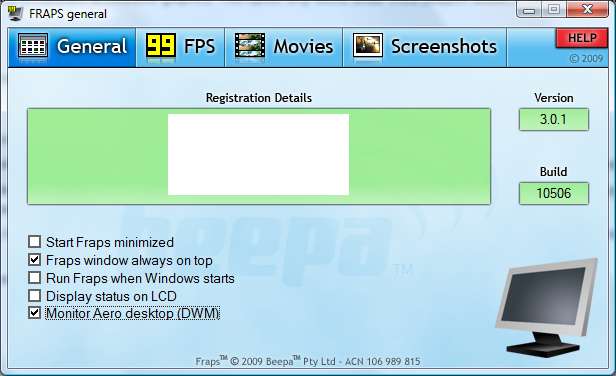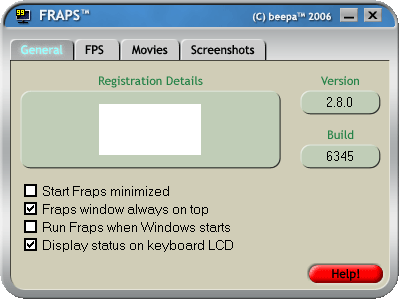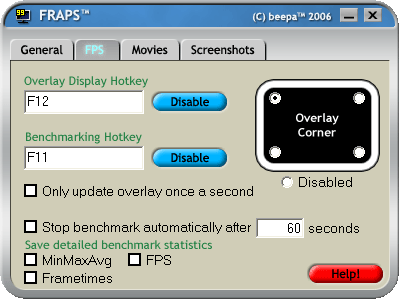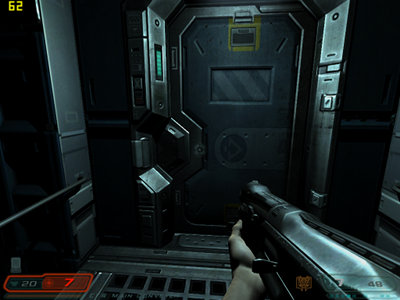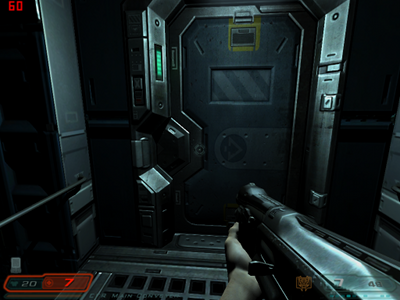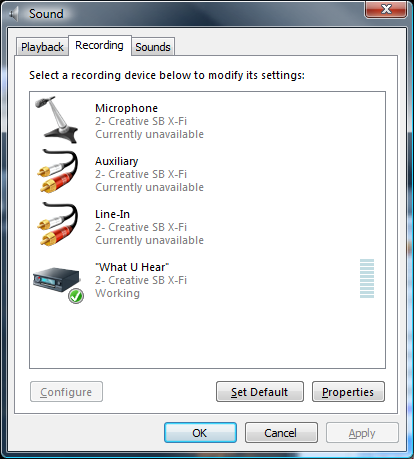Digital Capture
From SDA Knowledge Base
Capturing a PC game is both easier and harder than capturing a console game. Unlike consoles, a PC game is already transmitting its video information in digital format; the only thing that is needed is for this signal to end up in a file as well. However, doing so will require running a recording program alongside your game, which may or may not cause problems.
Contents
FRAPS
Introduction
FRAPS is by far the most commonly used method to record speedrun videos on the PC. For a long period of time FRAPS wasn't a very good program to use for this since it made games behave in weird ways and caused massive input lag, among other things. It has slowly been improved bit by bit and now it's actually a program you can recommend without being the slightest sarcastic. The program is running in the background and records the game you're playing, a process that's quite heavy on the hardware in most cases. Spite the hardware requirements FRAPS does have a few advantages over other recording methods such as DVD recorders.
1. Record in any resolution you want.
2. Extremely high quality recordings.
3. Easier encoding. No need to transfer your video from a DVD to your computer since it's already on your hard drive, ready for encoding.
4. No need to buy media such as discs.
5. Cheaper than a good DVD recorder.
The trial version of the program is not sufficient for recording runs for SpeedDemosArchive since it has a limit of 30 seconds per video and it also puts a watermark in them, and we do not like watermarks. The software can be bought for $37 which is much cheaper than buying a good DVD recorder, for example. Any updates after the initial purchase are free of charge. Other methods of acquiring the full version are not supported nor encouraged by SpeedDemosArchive.
Recommended Hardware
The hardware listed here is not critical to be able to record with FRAPS, this is recommended hardware for getting the best possible performance out of FRAPS.
Dual-core (or better) CPU: This will allow you to run the game and FRAPS on different CPU cores, significantly improving the recording performance.
2GB (or more) of RAM: Even though FRAPS isn't the most memory hungry application you want to make sure there's plenty of RAM to minimize the risk of sudden disk swapping that can ruin your recording.
2 hard drives: Same reason we want at least a dual-core CPU. Running the game on one drive while having FRAPS record to another will greatly improve recording performance. Note that drive partitions do not fall under this category, it has to be 2 physical drives.
Soundcard that can record using either Stereo Mix or ”What U Hear”: By far the easiest way of recording sound. Just about all soundcards will have Stereo Mix, somewhat modern Creative Soundblaster cards will have ”What U Hear” which is the exact same thing but with a ridiculous name.
Graphics card: Anything that has Nvidia GeForce or ATI Radeon printed on it. You want something that can at least keep a solid 30 frames per second when running the game with the resolution you're recording in. I have yet to find any solid information if the graphics card play any further role when it comes to FRAPS.
Single Disk Recording
Older games might in some cases be possible to record without issues using a single disk setup, but there's still a huge risk of recordings getting ruined by the disk accessing other files while you're recording.
FRAPS Application Settings
Note: This part of the guide is written for FRAPS version 3.x. If you're using an earlier version some settings will not be available.
The General Tab
Monitor Aero desktop (DWM): Enabling this feature can in some cases allow you to record games you normally wouldn't be able to record due to lack of hardware accelerated graphics. This option only works under Vista (support added in version 2.9.0) and Windows 7 (support added in version 3.0.0) when Aero is enabled. This feature will not work on XP.
FRAPS 3.x on the left, FRAPS 2.x on the right.
The FPS Tab
Overlay Corner: Depending on if there are important HUD elements in your game you might want to change the position of the Overlay Corner (highlighted with red in the picture) so it doesn't obscure important information. Just click the corner where you want FRAPS to display the fps counter.
FRAPS 3.x on the left, FRAPS 2.x on the right.
Hide overlay: Enabling this option is not recommended since the fps counter also indicates if FRAPS is recording or not.
In the left picture the counter is yellow. That means FRAPS is running in the background but isn't recording. In the right picture the counter is red. That means FRAPS is running and recording.
The Movies Tab
Folder to save movies in: Make sure this folder is located on a drive where you are not running any heavy applications such as the game you're recording. Also try to avoid recording to the drive where Windows is installed.
Video Capture Hotkey: Ideally you don't want this button anywhere near the buttons you're using in the game you're recording, you don't want to push this button by accident in the middle of a run. To change key simply click the field and then push the button you want to use.
Video Capture Settings (fps): Here you have to do a little trial and error to see what your computer is actually capable of recording at. If you are trying 60 and the fps isn't steady at 60 you have to lower the recording frame rate or else you will get a choppy video. 30 fps shouldn't be a problem for most systems, but this can vary greatly depending on the game you're recording. FRAPS will also cap the frame rate of the game to the frame rate you've chosen to record at.
Video Capture Settings (image size): This should in almost all cases be set to full-size. If you are recording a game where the graphics scale very badly, i.e getting really ugly as you lower the resolution, it can be better to run the game at a higher resolution and have FRAPS lower the video resolution through half-size recording. Full-size requires more of the hard drive while half-size requires more CPU power due to the extra processing of resizing the image.
Sound Capture Settings (main): Record XP/Vista/Windows 7 sound, always checked and set to Stereo. There are some settings in Windows necessary to make this work properly, we'll get to that in the Windows Settings section.
Sound Capture Settings (external input): Always disabled when recording content intended for SpeedDemosArchive. This option was added in version 3.0.0 and will therefore not exist if you're using an earlier version. It also won't work if you're using XP.
FRAPS 3.x on the left, FRAPS 2.x on the right.
Misc. Recording Settings Located In Movies Tab
Don't sync audio and video: Disabled.
Hide mouse cursor in video: Disabled.
Force lossless RGB capture: Having this option disabled is the recommended setting, but feel free to try with it enabled if you want to. Important about this option is that it will not improve the quality of the final encoding due to the video codecs used on SpeedDemosArchive. This option was added in version 3.0.0 and will not exist if you're using an earlier version.
Screenshot Tab
No settings here are important for your recordings.
Windows Settings
Note: This part of the guide is done using Windows Vista. Menus and options might look different on other versions of Windows.
Drivers
Make sure you have the latest official drivers for everything. Do not use third-party drivers when recording with FRAPS.
Driver Download
This is a list of the most commonly used official drivers/driver packages. These links will point you to the manufacturer's driver download section, not directly to driver installation files.
AMD/ATI chipset, integrated motherboard features and graphics.
Creative sound.
Intel chipset and integrated motherboard features.
Nvidia chipset, integrated motherboard features and graphics.
Sound Recording
To get to the recording options click the Start Menu icon, settings, Control Panel, Sound, Recording.
It should look something like this.
Make sure that Stereo Mix or What U Hear is selected as the default recording device. Sound recording with FRAPS should now work without problems.
Game Settings
These settings will vary greatly depending on the game you're recording, but there are a few rules of thumb that goes for most games. In most cases you want to go with image quality settings that are referred to as ”normal” or ”medium”.
Anisotropic Filtering: Turn this off.
Anti-Aliasing: Turn this off.
Nvidia PhysX: Turn this off.
Not only do these settings raise the bitrate requirement for the video, they also put a lot more stress on your graphics card(s) which in turn might prevent you from running the game at a solid recording frame rate. Solid recording frame rate is more important than in-game graphics.
Vsync/vertical retrace: If you're experiencing lag in your game turn this off. Do not be alarmed if you see tearing, it will not show up in your video since the video frames are captured before they're sent off to the monitor.
Can I Record All Games With FRAPS?
Unfortunately not. FRAPS works great for games that are using DirectX, OpenGL or DirectDraw, although versions prior to 2.9.9 might have some issues with DirectDraw. Games using different rendering methods will in many cases not be possible to record, this method might solve some problems.
To Think About Before Recording
Shut down or disable any programs that might interfere with the game or FRAPS. Typical programs that possess this ability are anti-virus programs and instant messaging services that play sounds or display pop-ups during events. VoIP and voice chat programs, such as Ventrilo or Skype, should be turned off or muted. P2P programs, such as BitTorrent, will access your hard drive(s) a lot which is going to interfere with FRAPS so make sure these are turned off as well.
Make sure that the hard drive you're recording to has plenty of free space and is defragmented. If you have a solid-state drive defragmentation is unnecessary and actually hampers performance, so avoid it if you have one of these.
Return to the front page.
